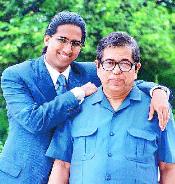Jim Rugg in collaboration with his creative partner, Brian Maruca, launched a series with the name of ‘Street Angel’, which became a major hit in the year 2004. The debutant work brought him instant fame and since then he has never looked back as he is occupied with similar other projects. Very deftly, he tells us his experience while he was working on the series of Street Angel, scroll down, to know more from the person himself,

1. Would you please give us a little biographical sketch about yourself?
Rugg: I grew up in a small town about an hour south of Pittsburgh. Started reading as well as drawing comics when I was 12. Went to a small state college, where I studied Graphic Design. Moved to Pittsburgh after school, and began making comics in earnest around 2000.
2. Did you have any formal training/school, or did you take the self-taught path?
Rugg: I took drawing, painting and design classes in college. A lot of making comics is self-taught, but I also learned a lot in studio classes.
3. From where do you derive your source of inspiration?
Rugg: I’m not sure. It’s an obsession, like an addiction or mental condition. When I made my own comics, before anyone paid me for them, I would spend my evenings and weekends working on comics. Now that I make comics as a day job, I still spend my evenings and weekends making comics for my own amusement. If I wasn’t able to make comics for some reason, I’m sure I would find other creative endeavors to occupy myself. I can’t explain it, and I know people who are the same way, and people who are exactly the opposite and spend their free time doing nothing or watching TV for hours.
I think it’s just a compulsion that some people are born with.
4. What made you plunge into the ‘alternative comics’? We would like to hear your experience while working on your debutant work, ‘Street Angel’?
Rugg: I started reading alternative comics towards the end of college. I was tired of Marvel and DC and superhero style comics. I discovered Chester Brown, Dan Clowes, Chris Ware, Crumb, etc., and it was like my brain exploded. I made my own autobiographical comic and went to SPX (Small Press Expo – a show dedicated to independent comics) in 2000, and it was the most amazing thing ever – hundreds of cartoonists with original, beautiful work. I came home after SPX with a couple boxes of mini-comics (Xeroxed, hand-made comic booklets), and wheelbarrows full of inspiration. After that, I just wanted to make work that stood up to these incredible objects. I started sending comics to people whose work I liked, and they would give me feedback. I sought out other small press shows and contributed comics to alternative anthologies. It was an amazing experience, seeing that community of artists, and interacting with them. It was also an eye-opening experience. I learned that one person could make beautiful comics without expensive printing techniques or the assistance of a publisher.
After a couple years of doing ‘alternative’ types of mini-comics, I co-wrote a zine called the Dick Troutman Handy Dandy Pocket Guide to Successful Suicide. It was patterned after the Worst Case Scenario books, and featured step-by-step instructions on different methods of suicide, plus sidebars about potential hazards and benefits and bits of trivia about each method. This project left me feeling kind of morose. It was a little bleak, and afterwards I wanted something lighter.
I had received a few scripts around this time from aspiring comic writers looking for an artist. The scripts were violent, melodramatic, dark superhero stories. Very poorly done, but also ironically a fairly accurate reflection of what Marvel/DC/Image comics seemed to publish at the time. Despite their morbid, cliched concepts, the scripts were filled with enthusiasm and idealism. I loved that enthusiasm; it felt very honest to me, like the writers took their love of the medium and crafted this one, flawed but heartfelt script. So Brian Maruca (my co-writer) and I decided to try to make a superhero comic filled with that ridiculous level of enthusiasm and a naive, amateur level of craft. We had both lost interest in Marvel/DC superhero comics, so we tried to figure out what we didn’t like about them, and then do the opposite. Street Angel was the result.
5. Tell us something about ‘The Plain Janes’. How did you become a part of this major project?
Rugg: The PLAIN Janes is a graphic novel about a girl named Jane who moves to the suburbs and reinvents herself. She was the popular girl in her previous school, but after a life-changing experience, she finds herself in a position to start over. So instead of trying to be popular again, she befriends a group of outcasts (each of whom is named Jane or a variation there of) and finds purpose in making art. It’s a fun project. I’m not very familiar with young adult fiction, but I grew up watching John Hughes movies. So drawing a comic set in high school is pretty fun.
Shelly Bond, the editor of the Minx imprint, came across Street Angel and Afrodisiac (a 1970s style character Brian Maruca and I have done in some anthologies) and contacted me about doing some work for Vertigo. After a couple of emails, she mentioned PLAIN Janes. I read some of Cecil Castellucci’s work (Cecil is the writer of PLAIN Janes), liked it, and decided to give it a shot. The project came together shortly after I finished Street Angel, and the timing seemed like a sign plus Cecil and I hit it off right away.
6. You are able to delineate women characters closely, I mean, they are very much near to the truth. How are you able to do this?
Rugg: Two things influence the way I approach drawing girls and women. First, when I was in junior high school, my art teacher pointed out that I drew very unattractive female characters. I spent most of my time drawing Wolverine and the Hulk, so when I had to draw a woman and she resembled them, it didn’t look too good. I guess I just practiced drawing women to try to overcome this limitation. Second, it bothers me how women are portrayed in many comics, advertising, and other media. I don’t want to objectify my female characters by emphasizing one body type (one that is unattainable without surgery, unhealthy lifestyles, and digital manipulation). To me, it’s a lot more interesting to try to depict different body types, different posture, different facial features, clothing, etc. If someone likes the way I draw female characters, it’s probably due to these reasons.
7. Amongst your created work, which one is your all time favorite?
Rugg: Street Angel. She turned out a lot more fun than I ever expected.
8. How much time do you take to complete a single project?
Rugg: It varies. Each issue of Street Angel took about 3 months (but that was just evening and weekend time). PLAIN Janes took about 9 months. Not counting writing time, I spend between 5 and 20 hours on a page, depending on whether I’m lettering and coloring it.
9. I read it somewhere that you’d been signing your work with a pseudo name, ‘Dick Troutman’, here I am curious to ask, did you start your career with an assumed name, and what made you decide to drop it?
Rugg: You’re the first person to ever ask me about this. I started using a pseudonym because I was doing autobiographical work and thought that would make it seem less autobio or something. But after a couple years, I had made a bunch of friends through comics, and it was very awkward interacting with people under a fake name. So right before Street Angel came out, I decided to drop the pseudonym. Up to that point, my work consisted of mini-comics, so it was limited to a couple hundred copies of any given work. It was a good time to drop it.
10. Amongst all the present genres, why did you choose comics as a medium of entertainment?
Rugg: I like drawing and I like the way comics work with a series of static imagery and caricature. I also like how minimal the medium is. I can make an entire comic book by myself. That’s a pretty awesome thing. Getting it published might require some compromise, but overall, it’s a very free medium. When I first started reading comics, they were an outcast medium. That was exciting to me. I think people within comics knew you could do any kind of stories you’d like, but most people didn’t think much of comics or even bother to pay attention to them.
11. Is there any work which has caught your attention presently? If yes, would you like to share it with us?
Rugg: I enjoyed Brian Chippendale’s book, Ninja, a great deal. I just picked up the Fletcher Hanks reprint book. It’s fun. I’ve been enjoying Paul Grist’s Kane trade paperbacks from Image. I’ve been reading a lot of old comics and reprints – Kirby’s Newsboy Legion, Matt Baker’s Phantom Lady, Art Out of Time (the Picture Box book that features underappreciated and little known cartoonists from 1900-1969), Ogden Whitney Herbie comics. Right now I’m in the middle of Men of Tomorrow (Gerald Jones), and I finally plan to read Kavalier & Clay soon.
12. Where do you see yourself, let’s say, five years from now. Any plans for the coming year?
Rugg: I’m currently working on another volume of PLAIN Janes. I expect to finish that in the next 6 months. After that I’d like to write and draw a color series featuring the Afrodisiac. And in five years? Wow. I haven’t had a five-year plan in three years. I guess I’d like to have more Street Angel, Afrodisiac, and PLAIN Janes books. I also have a graphic novel I’d like to do in the next few years. In five years, hopefully, I’ll still be living without a cube job.
13. Finally, we would like to have your thoughts on the Instablogs News Network and all its related sites. Which one is your favorite?
Rugg: I don’t have a favorite. I’ve only come into contact with Instablogs recently. I find the site interesting. I think it’s a great idea, and expect to spend more time using it from now on.
Last but not the least, we’d like to thank Rugg for this fantastic interview, it is greatly appreciated, also we’d like to wish him luck for all his future endeavors.



